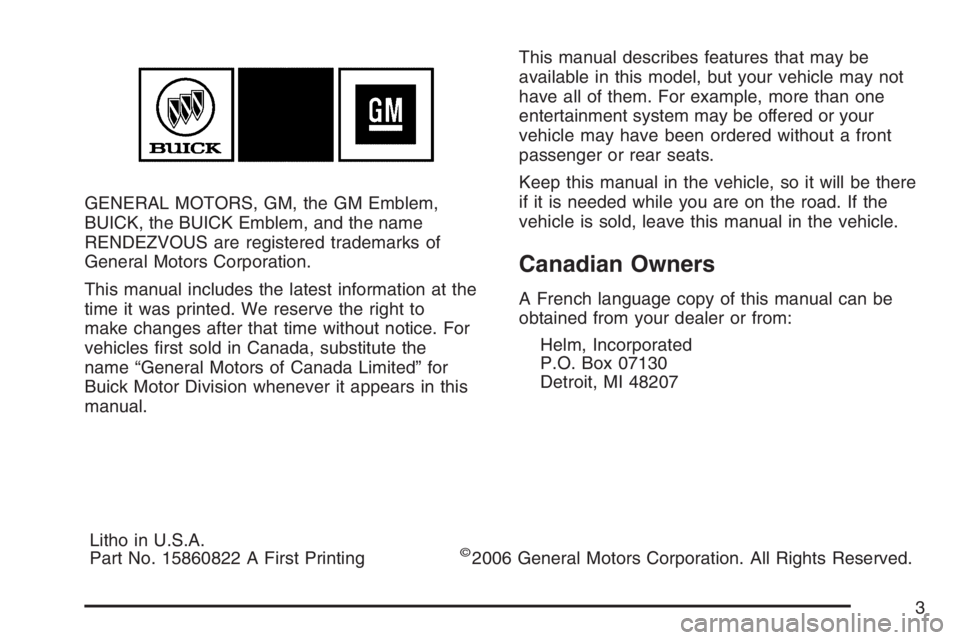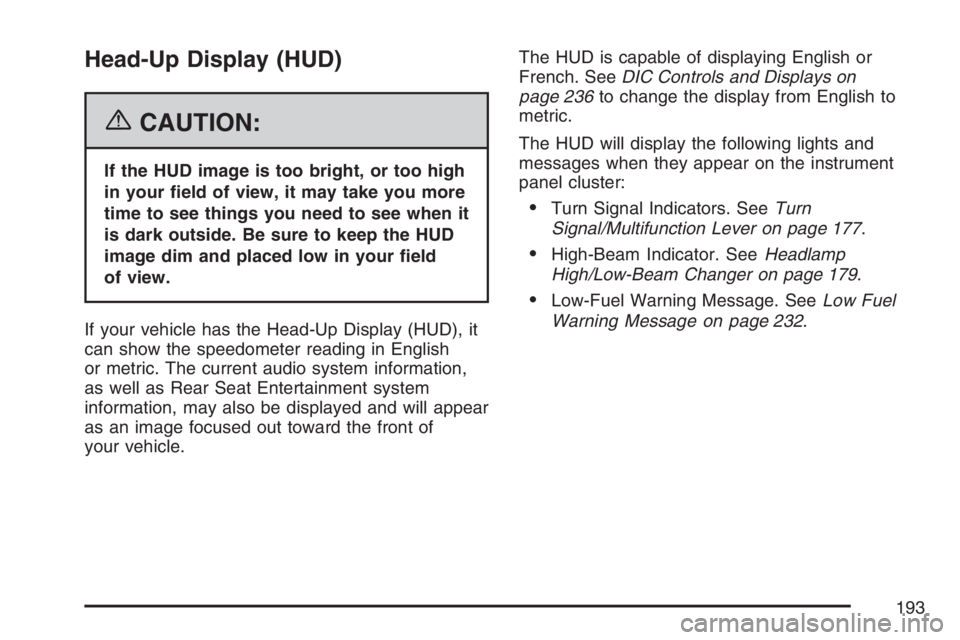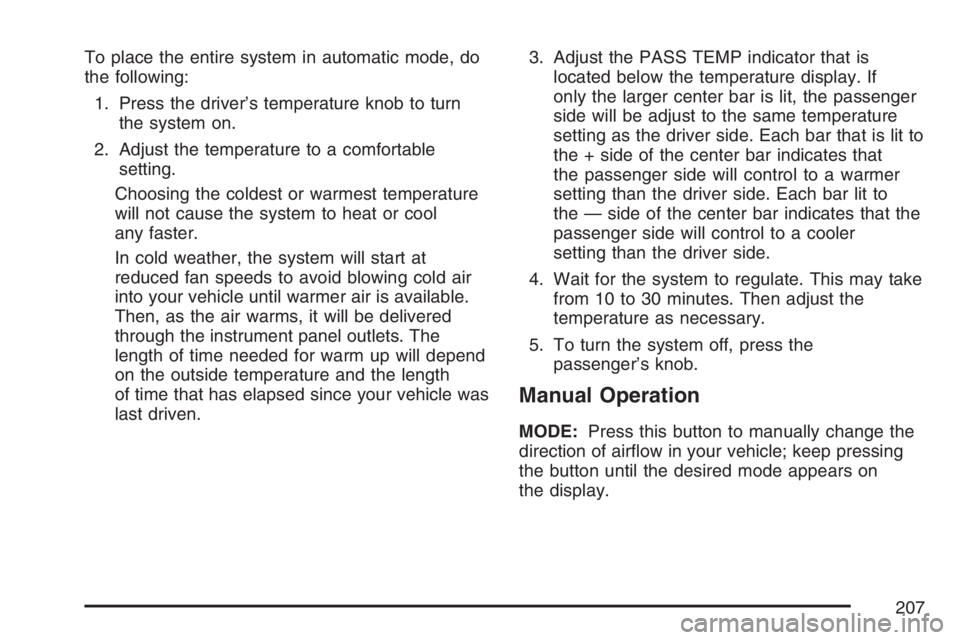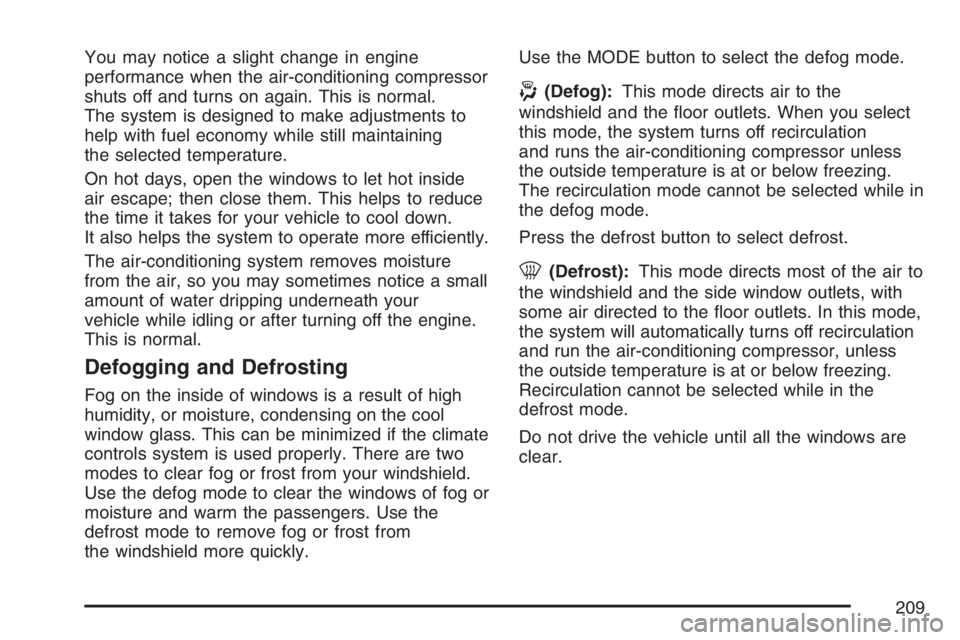change time BUICK RANDEZVOUS 2007 Owner's Manual
[x] Cancel search | Manufacturer: BUICK, Model Year: 2007, Model line: RANDEZVOUS, Model: BUICK RANDEZVOUS 2007Pages: 528, PDF Size: 2.99 MB
Page 3 of 528

GENERAL MOTORS, GM, the GM Emblem,
BUICK, the BUICK Emblem, and the name
RENDEZVOUS are registered trademarks of
General Motors Corporation.
This manual includes the latest information at the
time it was printed. We reserve the right to
make changes after that time without notice. For
vehicles �rst sold in Canada, substitute the
name “General Motors of Canada Limited” for
Buick Motor Division whenever it appears in this
manual.This manual describes features that may be
available in this model, but your vehicle may not
have all of them. For example, more than one
entertainment system may be offered or your
vehicle may have been ordered without a front
passenger or rear seats.
Keep this manual in the vehicle, so it will be there
if it is needed while you are on the road. If the
vehicle is sold, leave this manual in the vehicle.
Canadian Owners
A French language copy of this manual can be
obtained from your dealer or from:
Helm, Incorporated
P.O. Box 07130
Detroit, MI 48207
Litho in U.S.A.
Part No. 15860822 A First Printing
©2006 General Motors Corporation. All Rights Reserved.
3
Page 60 of 528

Infants and Young Children
Everyone in a vehicle needs protection! This
includes infants and all other children. Neither the
distance traveled nor the age and size of the
traveler changes the need, for everyone, to use
safety restraints. In fact, the law in every state
in the United States and in every Canadian
province says children up to some age must be
restrained while in a vehicle.{CAUTION:
Children can be seriously injured or
strangled if a shoulder belt is wrapped
around their neck and the safety belt
continues to tighten. Never leave children
unattended in a vehicle and never allow
children to play with the safety belts.
Every time infants and young children ride in
vehicles, they should have the protection provided
by appropriate restraints. Young children should
not use the vehicle’s adult safety belts alone,
unless there is no other choice. Instead, they need
to use a child restraint.
60
Page 130 of 528

Your vehicle has a Computer-Controlled
Cranking System. This feature assists in
starting the engine and protects the electrical
system. If the ignition key is turned to the
START position, and then released when the
engine begins cranking, the engine will
continue cranking until the vehicle starts or
until it exceeds the maximum cranking
time allowed, approximately 15 seconds to
prevent cranking motor damage. To prevent
starter-motor gear damage, this system
also prevents cranking if the engine is already
running. The engine cranking can be
stopped by turning the ignition switch to the
ACCESSORY or LOCK position.
Notice:Holding your key in START for longer
than 15 seconds at a time will cause your
battery to be drained much sooner. And the
excessive heat can damage your starter motor.
Wait about 15 seconds between each try to
help avoid draining your battery or damaging
your starter.2. If the engine does not start in 10 seconds,
push the accelerator pedal about one-quarter
of the way down while you turn the key to
START. Do this until the engine starts.
As soon as it does, let go of the key.
3. If your engine still will not start, or starts but
then stops, it could be �ooded with too much
gasoline. Try pushing your accelerator
pedal all the way to the �oor and holding it
there as you hold the key in START for
a maximum of 15 seconds. This clears the
extra gasoline from the engine. If the engine
still will not start, or starts brie�y but then
stops again, repeat Step 1 or 2, depending on
the temperature. When the engine starts,
release the key and the accelerator pedal.
Notice:Your engine is designed to work with
the electronics in your vehicle. If you add
electrical parts or accessories, you could
change the way the engine operates. Before
adding electrical equipment, check with
your dealer. If you do not, your engine might
not perform properly. Any resulting damage
would not be covered by your vehicle’s
warranty.
130
Page 152 of 528

5. After entering the switch settings, press and
release all three buttons at the same time.
The indicator lights will turn on.
6. Press and hold the button you would like to
use to control the garage door until the
garage door moves. The indicator light above
the selected button should slowly blink.
You may need to hold the button from �ve to
55 seconds.
7. Immediately release the button when the
garage door moves. The indicator light will
blink rapidly until programming is complete.
8. Press and release the button again. The
garage door should move, con�rming that
programming is successful and complete.
To program another device such as an additional
garage door opener, a security device, or
home lighting, repeat Steps 1 through 8, choosing
a different function button in Step 7 than what
you used for the garage door opener.Programming Universal Home
Remote — Rolling Code
Rolling code garage door openers are used for
garage doors produced after 1996 and are
code protected. Rolling code means the coded
signal is changed every time your remote control
garage door opener is used.
Programming a rolling code garage door opener
involves time-sensitive actions, so read the
entire procedure before you begin. If you do not
follow these actions, the device will time out
and you will have to repeat the procedure.
Follow these steps to program up to three channels:
1. Press the two outside buttons at the same
time for one to two seconds, and immediately
release them.
152
Page 171 of 528

Instrument Panel Overview........................ 174
Hazard Warning Flashers.......................... 176
Other Warning Devices............................. 176
Horn.......................................................... 176
Tilt Wheel.................................................. 177
Turn Signal/Multifunction Lever.................. 177
Turn and Lane-Change Signals................. 178
Headlamp High/Low-Beam Changer.......... 179
Flash-to-Pass............................................ 179
Windshield Wipers..................................... 179
Windshield Washer.................................... 180
Rear Window Wiper/Washer...................... 180
Cruise Control........................................... 181
Exterior Lamps.......................................... 185
Daytime Running Lamps (DRL)................. 186
Automatic Headlamp System..................... 187
Fog Lamps................................................ 187
Interior Lamps........................................... 188
Instrument Panel Brightness...................... 188
Interior Lamps Control............................... 188
Headlamp Exit Delay................................. 189
Entry Lighting............................................ 189
Delayed Lighting........................................ 190
Exit Lighting.............................................. 190
Perimeter Lighting..................................... 191Front Reading Lamps................................ 191
Rear Reading Lamps................................ 191
Cargo Lamp.............................................. 192
Battery Run-Down Protection..................... 192
Instrument Panel Switchbank..................... 192
Head-Up Display (HUD)............................ 193
Ultrasonic Rear Parking Assist (URPA)...... 196
Accessory Power Outlet(s)........................ 199
Ashtray(s) and Cigarette Lighter................ 200
Climate Controls......................................... 200
Climate Control System............................. 200
Dual Climate Control System..................... 203
Dual Automatic Climate Control System.... 206
Outlet Adjustment...................................... 210
Warning Lights, Gages, and Indicators..... 211
Instrument Panel Cluster........................... 212
Speedometer and Odometer...................... 213
Trip Odometer........................................... 213
Tachometer............................................... 214
Safety Belt Reminder Light........................ 215
Airbag Readiness Light............................. 215
Passenger Airbag Status Indicator............. 217
Brake System Warning Light..................... 219
Anti-Lock Brake System Warning Light...... 220
Section 3 Instrument Panel
171
Page 172 of 528

Traction Control System (TCS) Warning
Light...................................................... 220
Engine Coolant Temperature Gage............ 221
Malfunction Indicator Lamp........................ 222
Fuel Gage................................................. 225
Message Center.......................................... 225
Passenger Seatbelt Reminder Message..... 226
Service Traction System Warning
Message................................................ 226
Traction Active Message........................... 227
Engine Coolant Temperature Warning
Message................................................ 227
Charging System Indicator Message.......... 228
Reduced Engine Power Message.............. 228
Low Oil Pressure Message........................ 229
Change Engine Oil Message..................... 230
Door Ajar Warning Message...................... 230
Rear Hatch Ajar Warning Message............ 230
Check Gas Cap Message......................... 231
PASS-Key
®III Security Message............... 231
Low Washer Fluid Warning Message......... 231
Low Fuel Warning Message...................... 232
Low Brake Fluid Warning Message........... 232
Service Vehicle Soon Message................. 233Program Mode Message........................... 233
Remote Keyless Entry Transmitter Battery
Low Warning Message........................... 234
Parking Lamp Warning Message............... 234
Highbeam Out Warning Message.............. 235
Driver Information Center (DIC).................. 235
DIC Controls and Displays........................ 236
DIC Compass............................................ 238
DIC Vehicle Personalization....................... 240
Audio System(s)......................................... 250
Setting the Time........................................ 252
Radio with CD........................................... 252
Radio with Six-Disc CD............................. 262
XM Radio Messages................................. 276
Navigation/Radio System........................... 277
Rear Seat Entertainment System............... 277
Rear Seat Audio (RSA)............................. 293
Theft-Deterrent Feature............................. 296
Audio Steering Wheel Controls.................. 296
Radio Reception........................................ 297
Care of Your CDs and DVDs.................... 298
Care of the CD and DVD Player............... 298
Fixed Mast Antenna.................................. 299
XM™ Satellite Radio Antenna System....... 299
Section 3 Instrument Panel
172
Page 179 of 528

Headlamp High/Low-Beam Changer
To change the headlamps from low to high,
push the turn signal lever away from you, then
release it. To change the headlamps from high to
low, pull the lever toward you.
When the high beams
are on, this light on the
instrument panel
cluster and the HUD
display, if the vehicle
has this, will also be on.
Flash-to-Pass
When the headlamps are off, pull the lever toward
you to momentarily turn on the high beams.
This will signal that you are going to pass. When
you release the lever, they will turn off.
Windshield Wipers
WIPERN:Turn the band marked WIPER to
control the windshield wipers.MIST:For a single wiping cycle, turn the band to
MIST. Hold it there until the wipers start, then let go.
The wipers will stop after one cycle. If you want
more cycles, hold the band on MIST longer.
Delay:For delayed wiping cycles, you can set the
wiper speed for a long or short delay between
wipes. This can be very useful in light rain or snow.
Turn the band to choose the delay time. The
closer to LO, the shorter the delay time.
LO:For steady wiping cycles at low speed, turn
the band away from you to the LO position.
HI:For high-speed wiping, turn the band away
from you to the HI position.
OFF:To stop the wipers, turn the band to OFF.
Remember that damaged wiper blades may
prevent you from seeing well enough to drive
safely. To avoid damage, carefully clear ice and
snow from the wiper blades before using them. If
they are frozen to the windshield, carefully
loosen or thaw them. If your blades do become
damaged, get new blades or blade inserts.
Heavy snow or ice can overload your wipers. A
circuit breaker will stop them until the motor cools.
Clear away snow or ice to prevent an overload.
179
Page 193 of 528

Head-Up Display (HUD)
{CAUTION:
If the HUD image is too bright, or too high
in your �eld of view, it may take you more
time to see things you need to see when it
is dark outside. Be sure to keep the HUD
image dim and placed low in your �eld
of view.
If your vehicle has the Head-Up Display (HUD), it
can show the speedometer reading in English
or metric. The current audio system information,
as well as Rear Seat Entertainment system
information, may also be displayed and will appear
as an image focused out toward the front of
your vehicle.The HUD is capable of displaying English or
French. SeeDIC Controls and Displays on
page 236to change the display from English to
metric.
The HUD will display the following lights and
messages when they appear on the instrument
panel cluster:
Turn Signal Indicators. SeeTurn
Signal/Multifunction Lever on page 177.
High-Beam Indicator. SeeHeadlamp
High/Low-Beam Changer on page 179.
Low-Fuel Warning Message. SeeLow Fuel
Warning Message on page 232.
193
Page 207 of 528

To place the entire system in automatic mode, do
the following:
1. Press the driver’s temperature knob to turn
the system on.
2. Adjust the temperature to a comfortable
setting.
Choosing the coldest or warmest temperature
will not cause the system to heat or cool
any faster.
In cold weather, the system will start at
reduced fan speeds to avoid blowing cold air
into your vehicle until warmer air is available.
Then, as the air warms, it will be delivered
through the instrument panel outlets. The
length of time needed for warm up will depend
on the outside temperature and the length
of time that has elapsed since your vehicle was
last driven.3. Adjust the PASS TEMP indicator that is
located below the temperature display. If
only the larger center bar is lit, the passenger
side will be adjust to the same temperature
setting as the driver side. Each bar that is lit to
the + side of the center bar indicates that
the passenger side will control to a warmer
setting than the driver side. Each bar lit to
the — side of the center bar indicates that the
passenger side will control to a cooler
setting than the driver side.
4. Wait for the system to regulate. This may take
from 10 to 30 minutes. Then adjust the
temperature as necessary.
5. To turn the system off, press the
passenger’s knob.
Manual Operation
MODE:Press this button to manually change the
direction of air�ow in your vehicle; keep pressing
the button until the desired mode appears on
the display.
207
Page 209 of 528

You may notice a slight change in engine
performance when the air-conditioning compressor
shuts off and turns on again. This is normal.
The system is designed to make adjustments to
help with fuel economy while still maintaining
the selected temperature.
On hot days, open the windows to let hot inside
air escape; then close them. This helps to reduce
the time it takes for your vehicle to cool down.
It also helps the system to operate more efficiently.
The air-conditioning system removes moisture
from the air, so you may sometimes notice a small
amount of water dripping underneath your
vehicle while idling or after turning off the engine.
This is normal.
Defogging and Defrosting
Fog on the inside of windows is a result of high
humidity, or moisture, condensing on the cool
window glass. This can be minimized if the climate
controls system is used properly. There are two
modes to clear fog or frost from your windshield.
Use the defog mode to clear the windows of fog or
moisture and warm the passengers. Use the
defrost mode to remove fog or frost from
the windshield more quickly.Use the MODE button to select the defog mode.
-(Defog):This mode directs air to the
windshield and the �oor outlets. When you select
this mode, the system turns off recirculation
and runs the air-conditioning compressor unless
the outside temperature is at or below freezing.
The recirculation mode cannot be selected while in
the defog mode.
Press the defrost button to select defrost.
0(Defrost):This mode directs most of the air to
the windshield and the side window outlets, with
some air directed to the �oor outlets. In this mode,
the system will automatically turns off recirculation
and run the air-conditioning compressor, unless
the outside temperature is at or below freezing.
Recirculation cannot be selected while in the
defrost mode.
Do not drive the vehicle until all the windows are
clear.
209